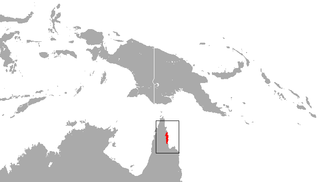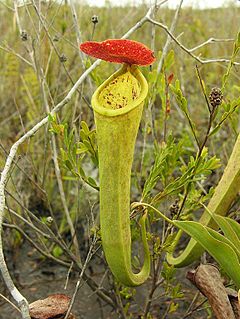Related Research Articles

Cape Melville is a national park in the Shire of Cook, Queensland, Australia.

Cliff Island is a national park at Yarraden on Cape York Peninsula in Far North Queensland, Australia, 1,757 km northwest of Brisbane. It is part of the Great Barrier Reef Marine Park west of Cape Melville in Princess Charlotte Bay. The park is a restricted access area in order to protect cultural resource of the islands traditional owners, the Lama Lama people.

Cape York Peninsula is a large remote peninsula located in Far North Queensland, Australia. It is the largest unspoiled wilderness in northern Australia. The land is mostly flat and about half of the area is used for grazing cattle. The relatively undisturbed eucalyptus-wooded savannahs, tropical rainforests and other types of habitat are now recognized and preserved for their global environmental significance. Although much of the peninsula remains pristine, with a diverse repertoire of endemic flora and fauna, some of its wildlife may be threatened by industry and overgrazing as well as introduced species and weeds.

Nepenthes rowaniae is a species of pitcher plant endemic to the Cape York Peninsula, Australia. It is closely related to N. mirabilis and was once considered an extreme form of this species.

The Djagaraga or Gudang are an Australian Aboriginal tribe, traditionally lived in the coastal area from Cape York to Fly point, including also Pabaju, in the Cape York Peninsula, Queensland. In the early period of white settlement as the Somerset tribe, after the settlement of Somerset established on their lands in 1863.

The cinnamon antechinus, also known as the Iron Ranges antechinus and the Cape York antechinus, is a species of small carnivorous marsupial of the family Dasyuridae. It is the only mammal endemic to Cape York Peninsula, being confined to semideciduous forest around the McIlraith and Iron Ranges. Along with the Atherton antechinus, it is the rarest in its genus.

Nepenthes tenax is a lowland species of tropical pitcher plant native to northern Queensland, Australia. It is the third Nepenthes species recorded from the continent and its second endemic species. Nepenthes tenax is closely related to the two other Australian Nepenthes species: N. mirabilis and N. rowaniae.

The Cape York rock-wallaby is a species of rock-wallaby restricted to Cape York Peninsula in northeastern Queensland, Australia. It is a member of a group of seven very closely related rock-wallabies, all found in northeastern Queensland, also including the Mount Claro rock-wallaby, the Mareeba rock-wallaby and Godman's rock-wallaby.
Cape Melville is a headland on the eastern coast of the Cape York Peninsula in Australia. To its west lies Princess Charlotte Bay. It is part of the Cape Melville National Park. Cape Melville was named Stoney Cape in 1815 by Lieutenant Charles Jeffreys on the HM Kangaroo but later renamed by him as Cape Melville
The Cape York mosaic-tailed rat, or Cape York melomys is a species of rodent in the family Muridae. It is found only in Australia, on the Cape York Peninsula.
The Cape York rat is a species of rodent in the family Muridae. It is found in southern New Guinea, in both Indonesia and Papua New Guinea, and in Cape York Peninsula in Australia.

The Papuan sheath-tailed bat is a species of bat in the family Emballonuridae which occurs at the Cape York Peninsula and New Guinea. The poorly known species hunts in open forests for night flying insects.

Henicopsaltria eydouxii, commonly known as the razor grinder, is a large species of cicada native to eastern Australia. Predominantly brown in colour, it is found in dry and wet sclerophyll forest in December and January and is quite common in Brisbane.

Henicopsaltria is a genus of cicada in the cryptotympanini tribe of the Cicadinae subfamily. Four species have been described. The razorgrinder is the type species.

Alwal National Park is a national park in the Shire of Cook on the Cape York Peninsula in Far North Queensland, Australia.
The Unduyamo (Andooyomo) were an indigenous Australian people who once lived around the northern shore of Newcastle Bay, Cape York Peninsula Queensland. It has been hypothesized that, among other aspects of their life, they functioned as religious specialists for Torres Strait Islanders, whose mastery of increase rituals attracted the native mariners from the north. Together with the Gudang, who apparently spoke the same language and whose territory ran from Cape York to Fly Point opposite Pabaju, the Unduyamo had strong cultural, kin and trade ties with the Kaurareg, the southwestern islanders centered around Muralag, with whom they enjoyed an alliance that permitted reciprocal residence on each other's territory. All three groups regarded the Yadhaigana and Gumakudin as hostile.
Nepenthes parvula is a tropical pitcher plant native to the Cape York Peninsula of Queensland, Australia.
Henicopsaltria rufivelum, commonly known as the jungle grinder, is a large species of cicada native to northeastern Australia.
Henicopsaltria danielsi, commonly known as the McIvor River grinder, is a large species of cicada found near Cooktown in northeastern Australia.
Ozimops halli, also referred to as the Cape York free-tailed bat, is a species of molossid bat found at the Cape York Peninsula in Australia.
References
- ↑ Australian Biological Resources Study (14 May 2012). "Species Henicopsaltria kelsalli Distant, 1910". Australian Faunal Directory. Canberra, Australian Capital Territory: Department of the Environment, Water, Heritage and the Arts, Australian Government. Retrieved 5 December 2017.